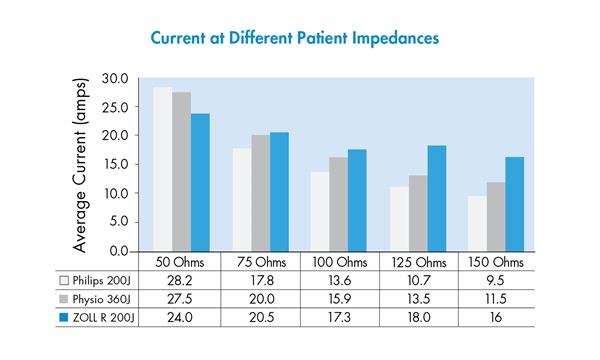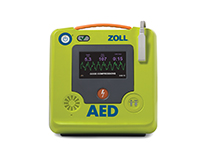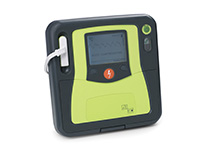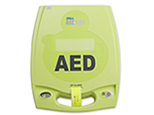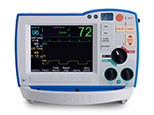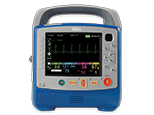Rectilinear Biphasic Waveform Technology
Defibrillators are often marketed as "high-energy" devices. The term “high-energy” actually refers to the electric current used by the defibrillator to shock a heart into a normal rhythm. Different defibrillators use different types of waveforms to deliver a shock. ZOLL AEDs use the low-energy, high-current ZOLL® Rectilinear Biphasic™ waveform (RBW), a waveform which provides more current than any biphasic waveform used in other defibrillators on the market today.
The Advantages of Rectilinear Biphasic Defibrillation
When compared to “high-energy” defibrillators, the ZOLL RBW offers many advantages. The high-current capability is particularly important for the difficult-to-defibrillate, high-impedance patient.
At 200 joules, bench testing data shown in the graph below demonstrated that the ZOLL RBW delivers more average current at mid- and high-impedances (≥ 75 Ω, which represents a majority in a typical patient population1) than any other biphasic waveform, including biphasic truncated exponential (BTE) waveform.
While both high- and low-energy BTE waveforms were adapted from internal defibrillation, the “high-current” RBW is the only biphasic waveform that was developed specifically for external defibrillation.2 It has been studied extensively in over 7,000 patients and shown to be superior to monophasic. In fact, the high-current ZOLL biphasic waveform is the only waveform that the U.S. Food and Drug Administration has approved to claim superiority* over monophasic waveforms.2
Monophasic Versus Biphasic Waveform Defibrillation
A monophasic waveform delivers electrical shocks in a single direction from one electrode to another. With a biphasic shock, the current travels in two phases. In the first phase, the current runs from the first electrode to the second electrode via the patient’s heart. Then, the current reverses direction and runs from the second electrode back to the first via the heart.
Biphasic defibrillators are now the industry standard for a couple of reasons. First, they are smaller and lighter than monophasic defibrillators. Second, they have been shown to be more effective in mitigating skin burns and injury to the heart due, in part, to biphasic waveforms delivering significantly less current.
RBW in particular has been shown to have superior efficacy compared with monophasic waveform in clinical studies for:
- Defibrillation of ventricular fibrillation in patients with mid and high impedance (> 70Ω)3
- Out-of-hospital cardiac arrest (OHCA)5
- Cardioversion of atrial fibrillation (AF)4,6
*The data demonstrate the equivalent efficacy of low-energy (aka, high-current) rectilinear biphasic shocks compared to standard high-energy monophasic shocks for transthoracic defibrillation for all patients at the 95% confidence level. The data also demonstrate the superior efficacy of low-energy rectilinear biphasic shocks compared to standard high-energy monophasic shocks in patients with high transthoracic impedance at the 90% confidence level. There were no unsafe outcomes or adverse events due to the use of rectilinear biphasic waveform.
1 Li Y, et al. Resuscitation. 2009;80:1312–1317.2 “The Heart of the Matter: What really defibrillates the heart?” ZOLL White Paper, 2015.
3 Mittal S, et al. Comparison of a novel rectilinear biphasic waveform with a damped sine wave monophasic waveform for transthoracic ventricular defibrillation. J Am Coll Cardiol. 1999;34:5:1999.
4 Mittal S, et al. Transthoracic cardioversion of atrial fibrillation: comparison of rectilinear biphasic versus damped sine wave monophasic shocks. Circulation. 2000 Mar;101:1282–1287.
5 Morrison LJ, et al. Out-of-hospital cardiac arrest rectilinear biphasic to monophasic damped sine defibrillation waveforms with advanced life support intervention trial (ORBIT). Resuscitation. 2005 Aug;66:2:149–157.

